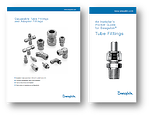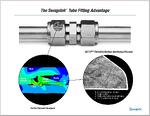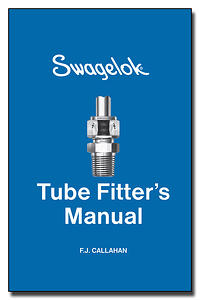Classic Publication on Swagelok® Tube Fittings Now Available Online
by Jeff Hopkins, on 3/12/14 8:00 AM
Even after 50 years, Swagelok's Tube Fitter's Manual is still the go-to guide
Back in 1963, Joe Callahan, Jr., wrote the book on tube fittings. Callahan went on to become the president of Swagelok Company, and his book, the Swagelok Tube Fitter's Manual, went on to become the industry standard.
Swagelok Company has updated and revised the content four times in the past 51 years, and now the entire 277-page publication is available online in PDF format. The 11 chapters cover the Swagelok® tube fitting itself, plus tubing specification and ordering, tubing and tube fitting handling and installation, severe service, troubleshooting, special purpose fittings, testing and evaluation of tube fitting performance, pipe threads, pressure ratings, the hidden costs of leakage, valves, and more.
As Callahan wrote in his most recent preface, "The well-known Swagelok two-ferrule fitting is the best tube fitting we know how to manufacture; however, proper installation and use of high quality tubing will go far to ensure leak-free connections."
The illustrated problems and solutions in the manual come from extensive field research and laboratory studies conducted by Swagelok Company's research and development engineers, plus feedback we have received over the years from our customers.
Tubing too
While the manual is primarily about our tube fittings, it also explains the importance of using the right tubing. For instance, for the tube fitting to work properly, the tubing material must always be softer than the fitting material. So, for instance, stainless steel tubing should never be used with brass fittings.
Tubing wall thickness is important too. If the wall is too thick, the fitting may not properly seal on it. If the tubing wall is too thin, it may collapse when the fitting is installed.
Proper tubing handling is important. Tubing should never be dragged off the delivery truck or storage racks, or across any hard surface. Dragging could score or scratch the tubing or knock it out of round, especially when it's made of a soft material such as copper or aluminum. Damaged tubing can lead to leaks, even with a high-quality fitting that is properly installed.
Callahan also wrote about proper tubing layout. For example, tubing should not be placed in a location where people are likely to use it as a rail for resting their feet, or to grab on overhead.
No trouble
Any complex system will have its share of challenges. The manual has a whole chapter on troubleshooting to keep frustrations to a minimum.
If the tube will not go into the fitting, for instance, there could be any of a half-dozen causes from burrs on the end to simply using the wrong size tubing. If the system leaks, there is a good chance the fitting was not installed properly. The manual explains what to look for when the leak happens after initial installation, after reassembly following maintenance, and under high temperatures.
So take some time to download and read a classic. You will get a better understanding of how Swagelok tube fittings work, and how to get the best performance out of them.
Additional Resources
 |
 |
 |
| Swagelok Northern California Infographic | Swagelok Tube Fitting Catalog and Guide | The Swagelok® Tube Fitting Advantage |



/Digital%20montage%20(1).jpg?width=1920&name=Digital%20montage%20(1).jpg)


